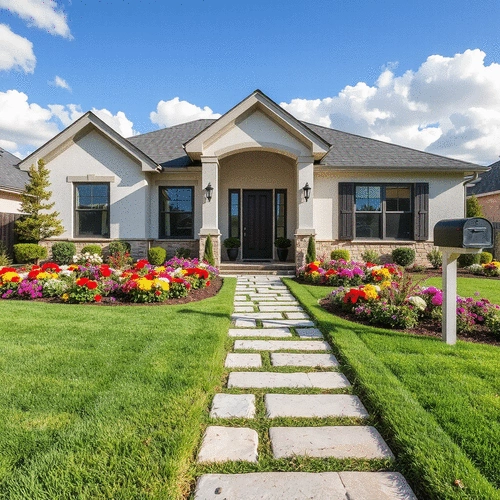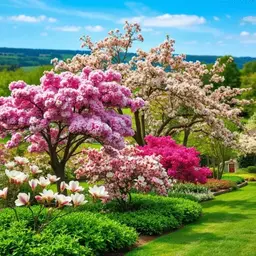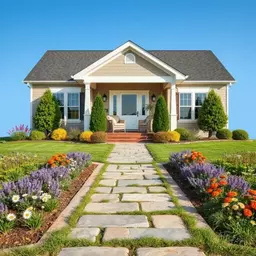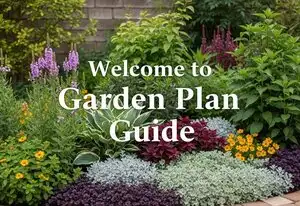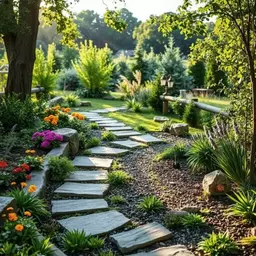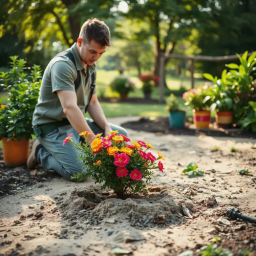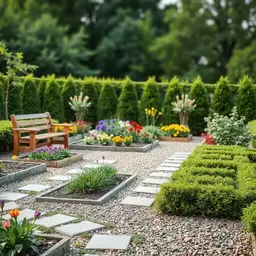Transforming your home's curb appeal can be a fulfilling journey, one that not only enhances the beauty of your property but also increases its value. If you've ever wondered how simple landscaping changes can create a lasting impression, you're in for a treat. Let’s discover practical tips and tricks that will make your outdoor space shine!
What You Will Learn
- Enhancing your lawn's health through regular mowing, proper watering, and smart fertilizing techniques.
- Selecting native plants that are low-maintenance and better suited for your local climate.
- Creating vibrant flower beds and strategic shrub placements to add color and texture to your landscape.
- Incorporating eye-catching design elements, such as rock gardens and unique focal points, to make your yard stand out.
- Utilizing outdoor lighting to enhance safety and create a magical ambiance during the night.
- Exploring budget-friendly landscaping solutions that make impactful changes without breaking the bank.
Key Landscaping Changes for Boosting Curb Appeal
Enhancing your home's curb appeal can be achieved through a series of strategic landscaping changes. Below are the summarized key tips for easy implementation. For more ideas on how to boost your property's exterior, consider plants that boost curb appeal.
Revitalize Your Lawn
Regular mowing, watering, and fertilizing can enhance its health and appearance.
Choose Native Plants
Opt for low-maintenance, drought-tolerant species that thrive in your area.
Create Vibrant Flower Beds
Use seasonal blooms and shrubs to add color and texture.
Design Eye-Catching Focal Points
Incorporate garden beds, rock gardens, and decorative elements.
Implement Outdoor Lighting
Use lights to highlight landscaping features and improve safety.
Transform Your Home's Curb Appeal with Easy Landscaping Changes
As a garden enthusiast, I know the magic that comes from enhancing a home's curb appeal! It’s all about making that first impression count, and let's face it—appearance truly matters when it comes to our homes. Curb appeal not only boosts your property's value but also creates a welcoming atmosphere that reflects your personality and style. So, let’s dive into some practical landscaping changes that can make a world of difference!
Understanding Curb Appeal and Its Importance for Homeowners
Curb appeal is the visual attractiveness of a property from the street, and it encompasses everything from your lawn to your front door! A well-maintained landscape can significantly increase your home's market value. According to real estate experts, properties with great curb appeal often sell faster and at higher prices. Isn't that encouraging? Imagine what a little effort can do for your investment!
It’s not just about the numbers, though! A beautiful exterior can uplift your mood each time you come home. You want your yard to tell a story, one that welcomes family, friends, and passersby alike. So, grab your gardening gloves, because together, we’re going to explore some simple yet effective landscaping changes! If you're looking for strategies, check out our guide on how to enhance curb appeal with DIY projects.
Practical Landscaping Changes to Immediately Boost Curb Appeal
Revitalize Your Lawn with Simple Care Techniques
Your lawn is the foundation of your landscape, and it's often the first thing visitors notice. Simple care techniques can make a big difference! Start by regularly mowing your grass to keep it neat and tidy. Here are some easy tips to revitalize your lawn:
- Water Early or Late: Watering in the morning or evening reduces evaporation and ensures your grass stays hydrated.
- Fertilize Wisely: Use a slow-release fertilizer to promote healthy growth without overwhelming your lawn.
- Weed Control: Regularly remove weeds to prevent them from competing with your grass for nutrients.
By following these simple steps, you can enjoy a lush, green lawn that instantly brightens your home’s exterior!
Utilizing Native Plants for Low-Maintenance Landscaping
When it comes to landscaping, choosing the right plants can save you time and effort. Native plants are a fantastic option because they thrive in your local climate and require less water. Consider planting:
- Daylilies: These vibrant flowers bloom throughout the summer and adapt beautifully to various soil conditions.
- Lavender: Not only does it smell divine, but it also attracts pollinators and requires minimal watering.
- Black-eyed Susans: Their cheerful yellow petals add a pop of color and are resilient in diverse environments.
By incorporating native plants, you create a beautiful garden that is easy to care for and supports local wildlife. You’ll be amazed at how these simple choices can elevate your outdoor space!
Incorporating Flower Beds and Shrubs for Added Color
Flower beds and shrubs play a crucial role in bringing color and life to your landscape. They can create a focal point or frame your home beautifully! Here are some tips for adding these elements:
- Layering: Use taller plants at the back of the bed and shorter ones in the front to create depth.
- Color Coordination: Pick a color scheme that complements your home’s exterior for a cohesive look.
- Seasonal Variation: Plant a mix of perennials and annuals to ensure color throughout the year.
Imagine stepping outside to a vibrant landscape that changes with the seasons—it’s a simple yet stunning way to boost curb appeal!
Creating Visual Interest with Strategic Landscaping Elements
Designing Eye-Catching Garden Beds and Rock Gardens
Creating visual interest is all about the details! Consider designing garden beds that catch the eye. You could also incorporate rock gardens as a unique focal point! Here’s how:
- Shape Matters: Choose curved or geometric shapes for your garden beds to add an interesting element.
- Natural Materials: Use stones or gravel for rock gardens to give texture and contrast to your landscape.
- Incorporate Focal Points: Add a decorative statue or birdbath to draw attention and spark conversation!
These elements not only enhance the beauty of your yard but can also serve as conversation starters. If you're considering a rock garden, our guide on building your own rock garden provides excellent tips. It’s all about creating a space that you love!
Enhancing Pathways and Outdoor Decor Features
Pathways can guide visitors through your garden and add a sense of flow to your landscape. Plus, the right outdoor decor features can bring your garden to life! Here are some ideas:
- Pathway Materials: Consider using stone, gravel, or wood chips to create inviting pathways.
- Decorative Features: Add elements like fountains, benches, or garden sculptures to create inviting spots to pause and enjoy.
- Bordering: Use low-growing plants or decorative stones to define your pathways clearly.
With these enhancements, you’ll create a charming space that feels welcoming and well thought out!
Utilizing Outdoor Lighting for Enhanced Ambiance
Outdoor lighting can transform your yard, making it feel magical at night while also improving safety. Here are some suggestions for lighting:
- Path Lights: Install solar-powered lights along pathways to illuminate the way for guests.
- Spotlights: Use spotlights to highlight key features such as trees or sculptures.
- String Lights: Hang string lights for a cozy, festive atmosphere in your outdoor spaces.
Good lighting not only enhances beauty but also adds functionality, letting you enjoy your garden long after the sun goes down.
Budget-Friendly Landscaping Solutions for Every Homeowner
Improving your home's curb appeal doesn’t have to break the bank! There are plenty of budget-friendly solutions that can still make a big impact. Let’s explore some simple steps you can take to freshen up your outdoor space without spending a fortune!
Pro Tip
Did you know that adding a simple border around your flower beds can enhance the overall look of your yard? Not only does it create a defined space, but it also prevents grass and weeds from encroaching on your plants. Consider using materials like decorative stones, wood, or even metal edging to give your garden a polished finish!
Wrap-Up: Key Insights for Easy Landscaping Changes
As we wrap up our discussion on landscaping changes that can boost your home’s curb appeal, it’s clear that even small modifications can create a big impact! From caring for your lawn to selecting native plants, every step counts toward creating an inviting and beautiful outdoor space. So, let’s summarize some of the top tips we've covered to help you get started!
Summarizing Top Tips for Better Curb Appeal
- Revitalize your lawn: Regular mowing, watering, and fertilizing can enhance its health and appearance.
- Choose native plants: Opt for low-maintenance, drought-tolerant species that thrive in your area.
- Create vibrant flower beds: Use seasonal blooms and shrubs to add color and texture.
- Design eye-catching focal points: Incorporate garden beds, rock gardens, and decorative elements.
- Implement outdoor lighting: Use lights to highlight landscaping features and improve safety.
These tips are just the beginning! Each one represents an opportunity to enhance your home's exterior while enjoying the process of gardening. Remember, your yard is a canvas waiting for your creative touch!
Encouraging Action for Your Landscaping Journey
Now that you’re equipped with a treasure trove of ideas, it’s time to take action! I encourage you to step outside and assess your yard. What changes excite you the most? Perhaps a fresh flower bed or a tidy lawn is just what you need to enhance your curb appeal. Don’t hesitate to start small—every little change adds value and beauty to your home!
Feel free to share your thoughts and ideas with us at Garden Plan Guide. We love hearing about your experiences and the transformations you undertake in your outdoor spaces!
FAQs on Easy Landscaping Changes and Maintenance
Many homeowners have similar questions about maintaining their gardens and making the best choices for their landscaping projects. Here are some common concerns and answers to help guide you:
Q1: How often should I water my lawn for optimal health?
A1: Generally, watering your lawn deeply once or twice a week is sufficient, depending on your climate and grass type. It's best to water in the early morning to minimize evaporation.
Q2: What are the benefits of choosing native plants for my landscape?
A2: Native plants are adapted to your local climate and soil conditions, meaning they often require less water, fertilizer, and pest control. They also support local wildlife and biodiversity.
Q3: How can I create visual interest in my garden without major renovations?
A3: You can create visual interest by adding focal points like unique garden beds, rock gardens, or decorative elements such as statues or birdbaths. Strategic planting of diverse heights and textures also helps.
Q4: What are some budget-friendly ways to improve curb appeal?
A4: Simple and affordable improvements include revitalizing your lawn, adding fresh mulch, planting seasonal flowers, tidying up pathways, and utilizing solar-powered outdoor lighting.
Q5: Why is outdoor lighting important for curb appeal?
A5: Outdoor lighting enhances the beauty of your landscape by highlighting key features, creates a welcoming ambiance, and significantly improves safety and security around your home.
- How often should I water my plants? Generally, watering in the early morning or late afternoon is best, about once a week, depending on your climate.
- What plants are best for low maintenance? Look for native plants like coneflowers, daylilies, or ornamental grasses that thrive naturally in your area.
- How can I reduce water usage? Implementing mulch around plants helps retain moisture and reduces the need for frequent watering.
Budgeting for Your Landscaping Projects
When planning your landscaping budget, it's essential to include all potential costs. Here’s a practical breakdown to help you stay on track:
- Soil and amendments: $50 - $200 depending on the area.
- Plants and seeds: $30 - $500 based on your selections.
- Mulch and decorative stones: $40 - $150 for coverage.
- Tools and equipment rental: $20 - $100 for necessary tools.
Planning ahead can make all the difference! Keeping these costs in mind will help you create a beautiful garden without breaking the bank. For more budget-friendly ideas, explore our article on budget drought-tolerant garden ideas.
Incorporating Visuals and Resources for Better Engagement
To make the most of your landscaping journey, consider using helpful tools and resources. Here are some suggestions:
- Garden planners: Online tools can help you visualize your design before you start.
- Before/after galleries: Browse inspiring transformations to spark your creativity!
- Design inspiration sources: Websites and magazines dedicated to gardening can offer fresh ideas.
These resources will guide you as you embark on your landscaping adventure. It’s like having a gardening buddy alongside you!
Exploring Sustainable Landscaping Practices
Finally, let’s talk sustainability. Taking a green approach not only benefits the environment but can also enhance your curb appeal! Here are some eco-friendly practices to consider:
- Using organic fertilizers: These promote healthier plants without harming the ecosystem.
- Installing rain barrels: Collect rainwater for watering your plants—it's cost-effective and resourceful!
- Choosing native species: They require less water and care, making them a sustainable choice.
By embracing these practices, you will contribute to a healthier planet while creating a stunning landscape. Remember, at Garden Plan Guide, we’re here to support you every step of the way on your landscaping journey!
Recap of Key Points
Here is a quick recap of the important points discussed in the article:
- Revitalize your lawn: Regular mowing, watering, and fertilizing can enhance its health and appearance.
- Choose native plants: Opt for low-maintenance, drought-tolerant species that thrive in your area.
- Create vibrant flower beds: Use seasonal blooms and shrubs to add color and texture.
- Design eye-catching focal points: Incorporate garden beds, rock gardens, and decorative elements.
- Implement outdoor lighting: Use lights to highlight landscaping features and improve safety.

